 By Robin Tandon, Director of Product Marketing, Cloud Solutions, HID Global
By Robin Tandon, Director of Product Marketing, Cloud Solutions, HID Global
The way ID cards are used on college and university campuses as well as in the enterprise has changed dramatically in recent years. Once a simple identification tool, corporate ID badges now provide the means to open doors and access IT systems, networks and data, and campus IDs are used to purchase meals, check out library books, enter dorm rooms, and more.
The way cards were issued had gone unchanged for two decades, using one or more PCs that were each connected to a nearby printer. Now, enterprises and universities are making a shift to cloud-based solutions that enable a remote card issuance experience, transform ID card printers into edge devices within the Internet of Trusted Things (IoTT), and redefine the economics of card issuance by ushering in new service-based models.
With the traditional issuance formula, ID cards were designed and printed from a PC that was connected to a nearby printer. Someone also had to be physically present at the PC to design the card, use the student ID database to encode data on the card, and send the card to a printer. Some suppliers added a piece of locally installed software that enabled web-based design and, in some cases, a certain level of encoding work.
In contrast, today’s true cloud-based card issuance platforms bring all the elements required for secure issuance into a centralized and integrated system that enables the entire process to be managed and executed remotely, from design and encoding to printing.
With cloud-based card issuance, an administrator in a card office or any satellite facility or remote location can seamlessly create new cards, encode data on them, issue replacements and manage print queues. This can all be accomplished through one trusted system using a tablet, laptop or any device with a web interface.
"Today’s true cloud-based platforms bring all the elements required for secure issuance into a centralized, integrated system that enables the entire process to be managed and executed remotely, from design and encoding to printing."
This cloud-based model improves the user experience by enabling instant issuance across different locations, rather than requiring a visit to the main card office in order to pick up an ID. Card printers can be installed anywhere, and cards can be sent to any of these printers. Printers essentially become smart, secure, web-enabled edge devices in the IoTT that can leverage all of the platform’s functionality.
Security and privacy protection are both improved with the cloud-based model. There is end-to-end encryption of all sensitive data both in transit and at rest, using banking-level encryption protocols. The use of digital certificates creates a trusted relationship between the cloud and the issuance console, and card data remains encrypted until it is printed, after which all personally identifiable information (PII) disappears.
All encryption keys are securely stored in tamper-proof hardware, and unique firmware ensures the printers cannot be hijacked, but will only work with the cloud-based issuance system software. The issuance console can also be used with a card reader so that print jobs are not released until an authorized card or credential has been physically presented for validation.
"The use of digital certificates creates a trusted relationship between the cloud and the issuance console, and card data remains encrypted until it is printed, after which all personally identifiable information disappears."
In addition to transforming security, privacy protection and the user experience, the cloud-based model also improves the admin experience by simplifying high-volume card issuance management and delivery, while increasing control and security.
With cloud-based card issuance, it’s no longer necessary to manage software and other IT resources typically required for card issuance. Since there is no longer the need for PCs to be locally connected to printers, the administrator is also saved the task of maintaining associated software updates and security patches across local computers connected to printers.
Not only does this approach eliminate the problem of using legacy systems that limit the ability for IT or security personnel to track system activity, it also eliminates any capital expenditure requirements for deploying printers as part of a world-class card issuance implementation. Instead, the cloud-based model introduces new economics for card operations, providing the option for resources to be leased and costs bundled into a cloud-based offering.
With a cloud-based platform, the entire ID card issuance process can be delivered through a service model billed on an annual or monthly-installment basis – including hardware, software and service.
This approach cuts multiple layers of program costs while making it easier for administrators to scale the card office to accommodate future technology capabilities or changing volume demands. For instance, during periods of peak demand, large batches of cards can be produced and dispatched by commercial printing bureaus.
A service model enables administrators to convert their budget for ID card issuance into an operational expense that could amount to a service fee covering all ribbons, pre-printed cards and mag stripe encoding. This approach diminishes the previous unpredictable ancillary costs associated with owning and managing hardware and software by eliminating costs related to maintaining hardware, inventory, labor, and potentially the capital expenditure related to purchasing printers.
The cloud-based service model can include auto-replacement of cards and other consumables when needed and can deliver all the benefits associated with centralized control and visibility along with distributed or batch printing.
"Administrators who adopt a cloud-based model for their card office know that their operations will be compatible with today’s and tomorrow’s credential technology, including mobile IDs."
Cloud-based card issuance solutions are aware of printer health and maintenance needs, as well as all activity down to the printer level, including the status of consumables. A service provider can, for instance, predict when a printer will run out of a consumable, and drop-ship replacements to the customer when they need them.
Equally important, administrators who adopt a cloud-based model for their card office know that their operations will be compatible with today’s and tomorrow’s credential technology, including mobile IDs. Solutions are generally also compatible with leading card systems.
An example is HID Global’s HID FARGO Connect secure cloud-enabled card issuance system, which is compatible with systems including the CBORD solution for higher education and HID SAFE Enterprise software for managing identities and their access across physical access systems.
While the technology used by card offices had largely remained static, the technology available to most other operations in the enterprise and a university campus has advanced considerably. These advancements are improving how employees are onboarded and are making it easier for university students to seamlessly register for classes online, pay fees and be ready for classes on the first day without waiting in physical lines.
The crucial task of printing and issuing student IDs has now fully caught up with industry advancements, taking the inefficiency and inconvenience out of corporate ID badging, while helping to alleviate the Fall crunch time for university card office administrators. Cloud-based card issuance solutions are giving back both time and money while re-envisioning the way card offices operate.

David Stallsmith, Director of Product Management, ColorID
The prevailing thought, when it comes to mobile ID, is that a university has to purchase a complete solution from a single provider. But identity solutions vendor, ColorID, is championing a different perspective for how campuses can make the move to mobile.
From ColorID’s point of view, there’s a lot to take into consideration between the day a campus decides to pursue mobile and launch day. Looking at each of these factors, ColorID hopes to offer an alternative to universities interested in issuing mobile IDs to students.
ColorID spends considerable time on the road and in web presentations speaking with campus card professionals from universities of all sizes. One of the common threads across these conversations is mobile ID.
CR80News recently spoke with David Stallsmith, Director of Product Management at ColorID, to cover some of the common mobile ID questions he fields from campuses, and to hear about ColorID’s efforts around building mobile ID infrastructures for university clients.
“In conversations we’ve had with higher education professionals over the past 10 years, the most commonly mentioned hurdle in implementing a mobile solution has been cost. For starters, mobile credential providers charge as much or more than cards, for their virtual credentials.
Credentials are only keys to the systems they interface with, which likely means upgrades or replacements to infrastructure will be required.
"In conversations we’ve had with higher education professionals, the most commonly mentioned hurdle in implementing a mobile solution has been cost."
Infrastructure poses both financial and business problems for campuses that want to migrate to mobile. Door readers, electronic locks, points of sale, gates and MFDs must be upgraded, or more likely replaced, in order to read credentials on mobile devices. For some campuses, this could be thousands of reader replacements.”
“ColorID has relationships with several manufacturers that offer mobile credentials and the corresponding readers and locks. We’re also working with several software companies as they develop identity management platforms that will include mobile credential lifecycle management.
"Mobile ID your way, in your time. That encapsulates the ColorID approach."
We see the migration to mobile credentials as a longer-term process for most institutions. Those that are ready and able can purchase one of the turnkey mobile solutions from the one-card system providers that offer them. For the rest, we’re already providing mobile solutions and helping schools upgrade their infrastructures to be mobile-ready.
Mobile ID your way, in your time. That encapsulates the ColorID approach.”
“We’re developing parallel and alternative solutions to the those recently introduced by Transact, CBORD and others. Mobile solutions are still new and providers are busy developing a wide range of services that will bring flexibility, security, convenience and, we hope, affordability to this market.
One approach we're offering enables a university to issue and manage both cards and mobile credentials as a process separate from the one-card system. In this arrangement, the one-card system becomes the consumer of identity data, rather than its sole manager. For example, many universities have their own in-house identity management systems that provide these functions. As those systems age and become harder to maintain, we see a need for a modern commercial platform to replace them and bring support for newer systems like mobile ID.”
“We recognize that cards will be with us for a while longer and we will make sure that any mobile product or service we offer will work with existing card systems. In fact, we think our ability to support a wide range of solutions that can coexist with traditional one-card systems provides our customers with the ability to migrate to mobile at their own pace, as their institutional resources allow.”
“At the simplest level, purchasing and issuing mobile IDs from a manufacturer’s cloud portal such as HID or SafeTrust, and installing compatible readers at doors and POS would get an institution started down the mobile ID path.
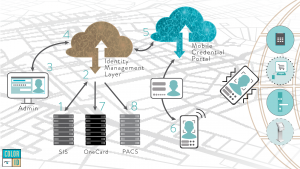
ColorID's mobile ID ecosystem.
HID has just introduced Signo, their latest generation of door readers, which are optimized for mobile credentials. SafeTrust, Lenel and many other manufacturers also offer credential, app, and reader combinations.
Going up a step, HID SAFE offers mobile ID management in the context of Physical Identity Access Management (PIAM). Several of our other partners are building cloud-based identity management platforms that are tightly integrated with card and mobile issuance systems.”
“The user experience and mobile ID performance for most campuses is still taking shape. Widespread adoption, competition resulting in a range of choices and prices, interoperability, and flexibility are all hallmarks of a maturing technology market. I don’t think we’ve seen anything like that yet as it pertains to mobile ID in the US university market.
Since adoption of mobile ID solutions will be a multi-year process for most schools that go in that direction, the ongoing introduction of new products and services to support mobile ID implementations are very much in process.
"The mobile-reader interface is important, but the identity management platform behind it is vital for a long-lasting, secure, and flexible system."
Schools know where to go to purchase the new, turnkey mobile offerings from Transact, CBORD, Atrium and TouchNet. Other mobile-first systems such as Foundry are also entering the market, which will put pressure on the traditional providers.
ColorID is bringing mobile ID and identity management solutions from other providers to market as they become available. Those schools that are taking more time to implement mobile now will ultimately find more options to select from when they are ready to make decisions down the line."
"We believe that a comprehensive identity management platform should be able to provision to any and all systems on campus that consume identity data. That platform should also be capable of managing a range of credential types.
Unlike mobile social apps which communicate directly with the cloud, campus mobile IDs have to interface with a lot of legacy and non-virtual systems. The mobile-reader interface is important, but the identity management platform behind it is vital for a long-lasting, secure, and flexible system.
Think about the now very mature ecosystem surrounding credit cards. The background processes involved in vetting you financially, provisioning that card, sending it to you, then recognizing the card at the POS, authorizing it through a real-time account verification, billing you for the transaction through your financial institution, and then reporting all of the above involves a huge number of interconnected systems. Systems that are constantly being updated and/or replaced. Who saw Square coming? We expect similar disruptive introductions to find their way into the university market.”
ColorID is providing more information about ways campuses can make the move to a mobile ID infrastructure on its website. ColorID is also covering this discussion in an engaging webinar format as part of its Campus Forum Series. The webinars are free to attend, and the company’s “Going Mobile for Under $1M” session will run on April 21, May 5, and May 21 at 1:00 p.m. EST.
The University of Connecticut will sublease a residence hall on its Stamford campus to the city of Stamford to house recovering COVID-19 patients.
According to an official university release, the 116-unit residence hall will shelter Connecticut residents recovering from COVID-19. The use of the residence hall is one of several ways in which UConn is helping the state respond to the global pandemic.
The temporary occupants will consist of those who have already been treated and discharged by local hospitals, but who still test positive for COVID-19. The residence hall will act as a place for these patients to recover in isolation without potentially exposing their families or others to the illness.
UConn had already packed and cleaned all of the rooms in the residence hall, as state officials had initially intended to use the building as part of its coronavirus response efforts.
UConn’s sublease agreement with the city of Stamford will see the city operate the six-story residence hall, including determining who will live there. The city will also absorb any costs incurred by UConn as a result of the city’s use of the building.
Stamford city officials will also arrange to have food and other items delivered directly to the recovering patients so they can remain isolated in the rooms as they rest and recover.
The dorm, constructed in 2017, offers apartment-style units with kitchens and other amenities. More than 300 UConn students were living in the building prior to the pandemic.
Fifty of those students – mostly international and those who couldn’t return home – were granted permission to remain in student housing and have now been moved from that property to UConn’s other residence halls. Student belongings left behind in the residence hall have been packed and are being stored until they can be safely returned to student residents.
UConn has also packed and cleaned 333 rooms in residence halls at its flagship Storrs campus for potential use by state or other entities for medical personnel or recovering patients.
As is the case at Stamford, students remaining in housing at the Storrs campus are primarily international students, those who have no safe home they can return to, or those who have been prevented from traveling.
Despite a vast majority of students returning to their homes for the remainder of the academic calendar, many universities are still serving a small number of students for whom traveling home isn't an option. Vanderbilt University is one such campus, and Vandy Campus Dining has established a care package service for its remaining on-campus residents to help them during the pandemic shutdown.
According to an official university release, there is a small group of undergraduate students who are still living on campus, and Vanderbilt Campus Dining is committed to its mission of maintaining a supportive and welcoming campus environment by providing some of the necessities to these students.
Vanderbilt's Campus Dining team is distributing care packages to all on-campus residential students who visit the university's Rand Dining Center.
“This is a challenging time for our on-campus students, and we look forward to a time when we can share a meal together in our dining halls once again," says Sean Carroll, director of marketing and communication for Vanderbilt People and Business Services. "Hopefully these care packages can help lift spirits."
The care package initiative was formulated and is being spearheaded by the Campus Dining Markets team. Each care package contains some of the comforts of home including toiletries, snacks and various dorm essentials.
Also in response to COVID-19, Vanderbilt Campus Dining has recognized that students aren't the only ones in need of a lift during the pandemic. Vandy dining has reconfigured its operations to also serve essential campus staff, residential faculty, Vanderbilt Child and Family Center students, and the first responders of Vanderbilt University Public Safety.
Vandy Campus Dining chefs are now preparing three meals per day, served grab-and-go style, from its Rand Hall location. The grab-and-go meals are available via a new SMS text message-based online ordering platform for delivery.
The meal prep and delivery operation is staffed entirely by rotating shifts consisting of Campus Dining management. The initiative is currently producing around 700 meals daily and is operating seven days per week.
COVID-19 has disrupted lives across the world. As cases began to rise in North America, colleges and universities were forced to quickly close campuses. Students and staff were sent home and transitioned to remote learning and work.
In response to early needs expressed by its customers, CBORD launched a relief program for GET CBORD Student schools, offering free mobile ordering for on-campus dining. Additionally, the company expanded its partnership with Grubhub to provide more options for mobile food ordering and contactless delivery.
[infobox type='success' title='A Healthy Return Webinar Series']
Registration now open for the first session.[/infobox]
Both meal ordering programs could be quickly and virtually implemented for customers already on the commerce platform.
“When everything began closing in early March, our team leaped into action to arm customers with information and resources to help adjust operations to serve their communities and patrons,” says Jim Hoefflin, CBORD and Horizon Software president. “A lot of quick decisions had to be made, and we’re still unsure of what to expect over the next few months as campuses reopen at a pace that is right for their community.”
Guidelines seem to be changing every day, leaving some universities unsure about fall semester. Some campuses are considering a late start, with a shorter, more condensed term, while others may decide to continue remote learning.
But whatever the future may hold, campuses are now beginning to strategize and plan for on-campus life in the wake of the pandemic lockdown.
With this in mind, CBORD is launching a FREE webinar series beginning Tuesday, April 28, designed to help universities in reopening facilities with a focus on making the campus environment healthier. The series, entitled A Healthy Return, will feature sessions throughout May, June and July covering topics for card office, food service, security, IT, and housing staff.
“Life won’t return to normal automatically for any of us, and social distancing will be in place for a while,” says Hoefflin. “For our higher education customers, this may mean remotely issuing campus credentials, limiting the number of people allowed in a building or room, reopening closed residence halls to accommodate single occupancy, possibly shrinking class sizes, ensuring environments and equipment are properly sanitized, and enabling contactless technology to prevent the spread of germs.”
So what does a “healthy return” to campus mean?
“We want what every administrator, faculty, and staff member wants – for campus communities to be healthy and safe,” says Read Winkelman, vice president of education sales at CBORD. “People need to be reassured that they can go back out into the world, to shop, visit friends and family, go to class, exercise, go out to eat, and continue on with ordinary life.”
It’s also critical for universities to reassure students and parents that their campus is a safe place to study, work and live.
“A healthy return means high-traffic, high-touch surfaces are sanitized; procedures are in place to practice social distancing; contactless payments, access, and delivery of goods are available; and most importantly, that our customers are doing absolutely everything they can to take care of their campus communities,” explains Winkelman.
A panel of CBORD team members who have experience working on college campuses will lead the first of the webinars. They’ll share insight from their past experiences in various university departments and offer advice on how to plan and prep for students returning to campus.
“I think the next couple of weeks will be telling as states lift stay-at-home orders,” says Winkelman. “The way communities respond will help colleges and universities better determine plans to reopen.”
All sessions for the “A Healthy Return” webinar series are free and open to anyone working in higher education. The one-hour sessions will include designated time for viewers to submit questions, and all presentations will be recorded and posted on the CBORD website for anyone who can’t attend live.
“Reopening campuses will require a lot of planning and teamwork to ensure students, faculty, and staff can return to a safe, healthy environment,” says Hoefflin. “We’re in this together and will continue to serve alongside our customers.”
Register here for the first webinar session.
The coronavirus pandemic has forced a number of campus housing changes. Michigan State University's Housing Assignments Office is already looking to the summer with new options for students intending to live on the East Lansing campus this summer.
Closures and restrictions as a result of the COVID-19 pandemic have led MSU to implement a couple of new options not offered in previous years. Unlike past summers, this year there will be some students that may have no other choice but to remain on campus as a direct result of the COVID-19 pandemic.
Michigan State University Residence Education and Housing Services is accounting for both planned campus construction projects and health and safety concerns due to COVID-19, with summer housing assignments providing students their own room in a suite-style hall.
Students who can't return to their homes due to the pandemic can begin the summer housing sign-up form on their student account and indicate if both a housing and dining plan are needed.
The offer isn't just for students who cannot return home due to the COVID-19 pandemic. Michigan State is offering any current students to live on campus free of housing charges during summer 2020, with the purchase of a summer dining plan.
To be eligible for the offer students must purchase an unlimited summer dining plan and have one of the following:
The University of Pennsylvania is joining peer campuses across the country in issuing pro-rated refunds to students who paid for room and board plans during the spring semester. With campus closures affecting Penn in the same way institutions all over the country have been, the university has laid out a student refund plan.
As reported by The Daily Pennsylvanian, Penn has outlined a concrete plan to issue pro-rated housing and dining refunds to students living in on-campus housing or who paid for a campus meal plan. The news was circulated to the Penn community via email from Penn Residential Services.
Any Penn students on dining plans will be refunded for their remaining spring semester meal plan balance. On-campus residents departing the university or graduating will receive pro-rated reimbursements in May to their student billing accounts.
The refunded dining credit value will be based on the student's total number of remaining meal swipes, calculated at the cost-per-swipe of their specific dining plan. Any unused Dining Dollars will also be refunded at a dollar-for-dollar ratio.
University officials determined that the value of the refunded room and board funds would cover the time between March 17 to May 13, the last day of student housing contracts.
The email also reveals that the housing and dining refunds will be reflected in students' May billing statements. The credited amount will first be applied to any outstanding balances on student accounts, with the remaining funds being be reimbursed to students' via their preferred payment method through Penn's online billing system.
In an effort to help its surrounding community, staff members from the University of Kentucky dining services have partnered with local organizations to prepare meals for those in need.
According to an official university release, UK Dining chefs have provided some 200-300 meals per day to people in need over the last two weeks. The university has partnered with local Lexington, Ken. food pantries and charities on the initiative.
“We stand by the Lexington community as this is where we live, work and play,” says Pulkit Vigg, resident district manager for UK Dining. “Being the flagship program in Kentucky, it’s our responsibility as well to extend support where and when it’s needed.”
The university has partnered with The Nathaniel Mission, Lighthouse Ministries, Moveable Feast, The LEE Initiative in conjunction with Great Bagel, God’s Pantry, Fayette County Public Schools and FoodChain.
Lexington area food banks have felt the impact of the coronavirus pandemic, seeing an increased need for food assistance.
The organizations UK has partnered with are facing an increased need for assistance amid the coronavirus pandemic. UK reports that food distribution organizations are seeing an estimated 35% increase in need from those who are food insecure.
In addition to helping the surrounding community, the initiative has also given university employees an opportunity to continue working while the UK campus is closed. UK Dining plans to continue donating the nutritious, family style meals as long as they have the donated food and labor resources available.
Enterprise Rent-A-Car has started a new initiative designed to help college students get home in response to coronavirus-related campus closures. The rental car company is waiving its young-renter fee and reducing the minimum age to rent a vehicle from 21 to 18 years old.
A release from Enterprise reveals that the change is effective now through the end of May at all rental locations in the United States.
Universities across the country are in the midst of campus closures as the response to the COVID-19 pandemic continues to alter daily operations. This has led a majority of students to return to their homes and move out of campus lodging.
Enterprise is trying to provide an option for those students that may need last-minute transportation, and expects that by lowering the age minimum and waiving the young renter fee, more students will be able to access rental cars if needed.
"We want to do whatever we can to make this unprecedented situation easier for students and their families," says Will Withington, Senior Vice President, North American Operations for Enterprise Holdings. "With an Enterprise Rent-A-Car location within 15 miles of 90% of the U.S. population, we're in range of nearly every college campus in the country and able to help students get wherever they need to go."
With the lower age limit, any students 18 to 24 will need to provide a valid driver's license and official student ID card to rent a vehicle. The reduced age and waived young-renter fees will remain in place through May 31, 2020.
Additional Enterprise College Student Rental Assistance info:
CR80News was onsite at last month’s Transact360, the annual Transact Campus user group conference. Great speakers, great networking, and a packed technology exhibit hall highlighted the three day event. Here are a few of the highlights from the expo:
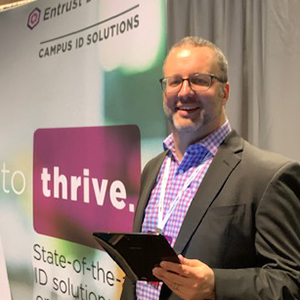 Retransfer printers, direct-to-card printers and distributed enrollment and issuance were the topics on tap for Entrust Datacard. Product Marketing Manager, Martin Hoff, said that modern card issuance is about “busting the lines.”
Retransfer printers, direct-to-card printers and distributed enrollment and issuance were the topics on tap for Entrust Datacard. Product Marketing Manager, Martin Hoff, said that modern card issuance is about “busting the lines.”
In the past, if a printer went down it could shut down the issuance process. With distributed issuance and the company’s TruCredential solution, you simply route the job to another location. Putting the card issuance software on a server enables this distributed issuance and lets the campus enroll cardholders anywhere on campus, not just in the card office.
 International students have added challenges when it comes to paying tuition at US institutions, and managing international payments is where Western Union thrives.
International students have added challenges when it comes to paying tuition at US institutions, and managing international payments is where Western Union thrives.
“We are fully integrated with Cashnet to help international students move money to pay tuition,” says Ben Kavalec, the company’s US director of sales.
Students make payments in their local currency and the institution gets paid in US dollars. The benefit for the student and their family is that they get preferential Western Union corporate rates for the transaction as it's a domestic payment for them rather than an international wire. If they went through their local bank to initiate the transaction, they would pay as an individual for an international wire at the highest rate.
Institutions also pay for receiving these international wires and the Western Union offering reduces these costs as well.
 Access control readers that can consume both the mobile credential and the physical card were on display at the Allegion booth. The company’s AD and NDE reader lines both accept mobile credentials, and Allegion can help campuses accept both iOS and Android devices in PACS environments.
Access control readers that can consume both the mobile credential and the physical card were on display at the Allegion booth. The company’s AD and NDE reader lines both accept mobile credentials, and Allegion can help campuses accept both iOS and Android devices in PACS environments.
Mark Casey, Director National Electronic Sales, says the biggest change this year is that people are making decisions when it comes to mobile first. “People were talking at the 40,000 foot level about what mobile could do, but now its shifted to action – how do we it and who do we involve."
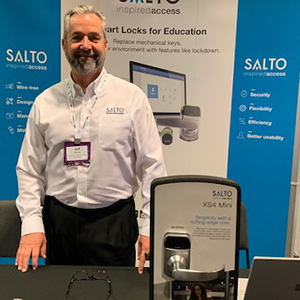 The mantra for access control provider Salto Systems has always been “data on card,” because they cleverly used the users’ cards to transport system-level data to their network of readers. Today that mantra has expanded to “data on phone,” as they recently rolled out mobile credential acceptance within their large deployed infrastructure at the University of Santa Clara.
The mantra for access control provider Salto Systems has always been “data on card,” because they cleverly used the users’ cards to transport system-level data to their network of readers. Today that mantra has expanded to “data on phone,” as they recently rolled out mobile credential acceptance within their large deployed infrastructure at the University of Santa Clara.
Jeff Wood, National Manager OEM at Salto, explains that their readers connect wirelessly not to find out if a cardholder has access to a door (they already know that based on data held on the card itself), but rather for managing system functions and enabling lockdown situations. “Data on card or data on phone still works with power outages as our locks are battery powered,” he says.
It’s also a cost effective install. “In a place like New York City, the end user cost could be $8,000 per door for a wired solution, but this gets that down to less than $1,000 and a five-minute install.”
A wide variety of biometric readers – from basic fingerprint-only readers to multi-factor devices and even contactless scanners – are serving higher ed installations thanks to IDEMIA.
The MorphoWave Compact is an option that is growing in popularity for use in unlimited access dining locations, rec centers and libraries, says Dave Gershenson, National Sales Manager for IDEMIA.
Gershenson has also seen a growing trend of scanning in and scanning out of academic facilities like libraries, as well as other on-campus locations. “In athletics, biometric access has become a recruiting tool to show off facilities to potential athletes,” he says.
 Many Transact readers and devices are made by a leading contract manufacturer that also happens to do good for our society.
Many Transact readers and devices are made by a leading contract manufacturer that also happens to do good for our society.
PRIDE Industries employs 3,400 people with disabilities across 16 states. That is more than half PRIDE’s workforce, so it's not just a PR move, but rather a core part of the company’s socially responsible mission.
According to Mike Douglas, PRIDE’s General Manager, PRIDE gives people a sense of purpose and gainful employment and that improves lives. Next time you use one of your Transact devices on campus, feel good knowing that lives were changed in its creation.
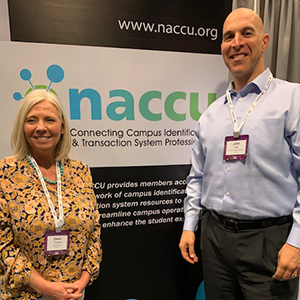 “We like to support our partners, and Transact360 and other user group events provide a great opportunity to connect and engage with the market,” says Dawn Thomas, Executive Director, NACCU.
“We like to support our partners, and Transact360 and other user group events provide a great opportunity to connect and engage with the market,” says Dawn Thomas, Executive Director, NACCU.
At the booth, Thomas, alongside membership engagement manager, John Ogle, met with a number of campus administrators – both members and potential members – to share association plans and learn what campuses need in terms of support.
NACCU provides both in-person and virtual educational opportunities throughout the calendar year targeted directly at higher education card and identity professionals.
 The sleek turnstiles from Alvarado would make a beautiful addition to any campus facility, and CooperCraft has installed them for Transact and other campuses.
The sleek turnstiles from Alvarado would make a beautiful addition to any campus facility, and CooperCraft has installed them for Transact and other campuses.
The optical barrier turnstiles are ideal for rec centers, student housing, dining halls and libraries, says Dan Gardner, Security Sales for Alvarado. He says that the turnstiles detect wrong-way entry and enforce one-to-one access by eliminating tailgating. It can also reduce staffing needs by removing the human the need for a person to scan ID cards at dining and other locations.
“We have turnstiles at Georgia State University providing data for their analytics on rec center usage,” explains Jerry Cooper, CooperCraft CEO. “They are great looking pieces and they can be customized with etching for each institution."
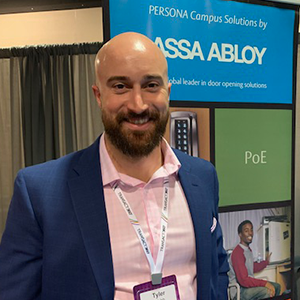 This spring, a new reader will join the Assa Abloy family that includes a keypad for situations when dual authentication is desirable.
This spring, a new reader will join the Assa Abloy family that includes a keypad for situations when dual authentication is desirable.
According to Tyler Webb, Assa Abloy Regional Manager, some campuses are seeking added security for residence halls. “We are hearing from institutions that are beginning to question if a single credential is enough for securing living spaces,” he says. "This new reader is designed to address that need."

